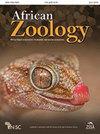两种同质范围受限壁虎的日活动模式表明对气候变化的特殊反应
IF 0.5
4区 生物学
Q4 ZOOLOGY
引用次数: 2
摘要
由于体温(Tb)和环境温度之间的密切关系,与环境条件相关的活动模式测量可以深入了解物种的生态驱动需求和气候偏好,特别是外热动物。隐尾Lygodactylus incognitus(隐尾矮壁虎)和苏特潘斯伯格Lygodacitylus soutpansbergensis(苏特潘伯格矮壁虎)是南非苏特潘斯堡山脉的一种范围有限的特有种,最近被证明可能容易受到气候变化的影响。这促使我们研究这些同生物种的温度调节特性与环境温度之间的关系。在两个季节的扫描调查中,记录了活跃的壁虎(即避难所外的壁虎)和环境变量。基于每个物种的存在/不存在测量和环境变量,使用二项式逻辑回归来预测和解释活动。在测量的变量中,空气温度(Ta)是两个物种活动的主要预测因子。与Soutpansberg侏儒壁虎相比,隐缩壁虎在较冷的Ta环境中比在较高的温度下更活跃。因此,隐蔽的矮壁虎很好地适应了温和的环境。Soutpansberg侏儒壁虎似乎很适合温暖的环境,因为它们更有可能在更高的Ta下活动。我们的研究结果表明,这两个物种都会随着气候变化而改变日常活动时间,但神秘的矮壁虎可能比苏特潘斯伯格矮壁虎受到更大的负面影响,因为它们对较低温度的亲和力和对研究期间最热温度的避免。因此,尽管这些广泛同域、同域、范围受限的物种关系密切,生活史相似,但它们占据着不同的热位,可能对气候变化做出特殊反应。我们的研究结果提醒人们不要过度使用代理物种来预测气候变化引起的物种地理分布变化。本文章由计算机程序翻译,如有差异,请以英文原文为准。
Diel Activity Patterns of Two Syntopic Range-Restricted Geckos Suggest Idiosyncratic Responses to Climate Change
Measures of activity patterns in relation to environmental conditions provide insights into ecologically driven requirements and climate preferences of species, particularly for ectotherms, due to the strong relationship between body temperature (Tb) and environmental temperatures. Lygodactylus incognitus (cryptic dwarf gecko) and Lygodactylus soutpansbergensis (Soutpansberg dwarf gecko) are range-restricted endemics to the Soutpansberg Mountains, South Africa, and have recently been shown to be potentially vulnerable to the effects of climate change. This prompted us to study the relationship between the thermoregulatory characteristics and environmental temperatures for these syntopic species. Active geckos (i.e. those outside of a refuge) and environmental variables were recorded during scan surveys across two seasons. Binomial logistic regressions were used to predict and explain activity based on presence/absence measures and environmental variables for each species. Of the variables measured, air temperature (Ta) was the main predictor of activity for both species. Cryptic dwarf geckos were active in cooler Ta than warmer temperatures in comparison to Soutpansberg dwarf geckos. Cryptic dwarf geckos are thus well adapted to temperate conditions. Soutpansberg dwarf geckos appear well adapted for warmer conditions, as they were more likely to be active at higher Ta. Our findings suggest that both species will alter their daily activity times in response to changing climate, but that the cryptic dwarf gecko is likely to be more negatively impacted than the Soutpansberg dwarf gecko, due to their affinity for cooler temperatures and avoidance of the hottest temperatures exhibited during the study period. Therefore, although these broadly sympatric, syntopic, range-restricted species are closely related and have similar life histories, they occupy different thermal niches and are likely to respond to climate change idiosyncratically. Our findings caution against the overuse of proxy species in predicting species geographic distribution changes in response to climate change.
求助全文
通过发布文献求助,成功后即可免费获取论文全文。
去求助
来源期刊

African Zoology
生物-动物学
CiteScore
2.60
自引率
9.10%
发文量
18
审稿时长
>12 weeks
期刊介绍:
African Zoology , a peer-reviewed research journal, publishes original scientific contributions and critical reviews that focus principally on African fauna in terrestrial, freshwater, and marine ecosystems. Research from other regions that advances practical and theoretical aspects of zoology will be considered. Rigorous question-driven research in all aspects of zoology will take precedence over descriptive research. The Journal publishes full-length papers, critical reviews, short communications, letters to the editors as well as book reviews. Contributions based on purely observational, descriptive or anecdotal data will not be considered.
The Journal is produced by NISC in association with the Zoological Society of South Africa (ZSSA). Acceptance of papers is the responsibility of the Editors-in-Chief in consultation with the Editors and members of the Editorial Advisory Board. All views expressed are those of the author and not necessarily those of the Editors or the Department.
 求助内容:
求助内容: 应助结果提醒方式:
应助结果提醒方式:


